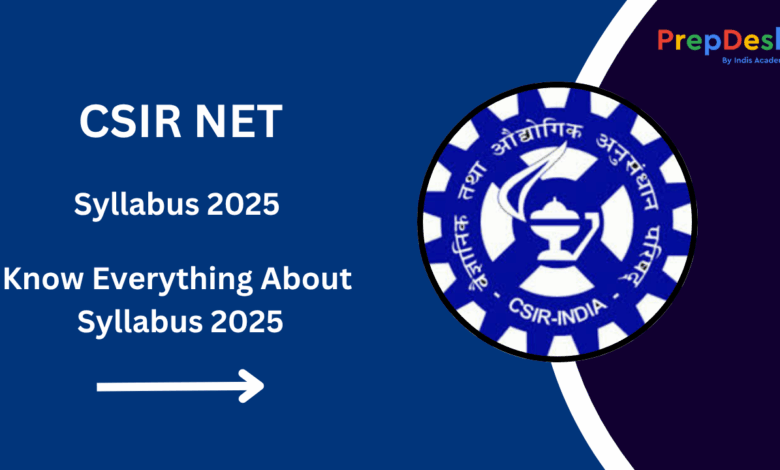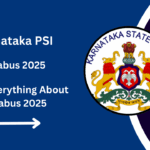CSIR NET Syllabus 2025: Detailed Part A, B & C Subject-wise Guide
Explore the comprehensive CSIR NET syllabus for 2025, covering all five subjects: Life Sciences, Chemical Sciences, Mathematical Sciences, Earth Sciences, and Physical Sciences. Understand the exam pattern, marking scheme, and download subject-wise PDFs to enhance your preparation.

CSIR UGC NET 2025 is a prestigious exam conducted by the National Testing Agency (NTA) to select candidates for Junior Research Fellowship (JRF) and Lectureship positions in science streams. This detailed article provides the complete CSIR NET syllabus 2025 with subject-wise topics, exam pattern, recommended books, PDF download links, preparation tips, and specialization scope.
CSIR NET 2025 Exam Overview
| Mode of Exam | Online (CBT) |
|---|---|
| Conducting Body | National Testing Agency (NTA) |
| Subjects | Life Sciences, Chemical Sciences, Physical Sciences, Earth Sciences, Mathematical Sciences |
| Medium | English & Hindi |
| Duration | 3 Hours |
| Total Marks | 200 |
| Question Types | Multiple Choice Questions (MCQs) |
| Parts | Part A (Aptitude), Part B (Subject), Part C (Analysis) |
CSIR NET Exam Pattern 2025
The CSIR NET 2025 exam pattern consists of three sections – Part A (General Aptitude), Part B (Subject Knowledge), and Part C (Higher Analytical Skills). The pattern slightly varies for each subject, but the overall structure remains consistent. Below is a comprehensive breakdown of each section.
| Section | No. of Questions | Questions to Attempt | Marks per Question | Total Marks | Negative Marking |
|---|---|---|---|---|---|
| Part A (General Aptitude) | 20 | 15 | 2 | 30 | Yes (0.5 per wrong answer) |
| Part B (Subject-based MCQs) | 25–50 (varies) | 20–35 | 2–3.5 | 70 | Yes (0.5–0.875 per wrong answer) |
| Part C (Analytical & Research-based) | 30–80 | 20–25 | 4–5 | 100 | Yes (1–1.25 per wrong answer) |
| Total | 200 Marks | Subject-specific | |||
Part A – General Aptitude (Common for All Subjects)
This section tests your numerical, logical, and reasoning skills. It is the same for all subjects and consists of:
- Number Series
- Algebra and Arithmetic
- Data Interpretation
- Graph and Table Analysis
- Reasoning and Puzzle Solving
Questions Asked: 20
To Be Attempted: 15
Marks per Question: 2
Total Marks: 30
Negative Marking: 0.5 per wrong answer
Part B – Subject Knowledge (Conceptual MCQs)
This section contains direct concept-based multiple-choice questions from your chosen subject (Life, Chemical, Physical, Earth, or Mathematical Sciences).
| Subject | Questions Asked | Attempt | Marks/Question | Total Marks | Negative Marking |
|---|---|---|---|---|---|
| Life Sciences | 50 | 35 | 2 | 70 | 0.5 |
| Chemical Sciences | 40 | 35 | 2 | 70 | 0.5 |
| Physical Sciences | 25 | 20 | 3.5 | 70 | 0.875 |
| Earth Sciences | 50 | 35 | 2 | 70 | 0.5 |
| Mathematical Sciences | 40 | 25 | 3 | 75 | 0.75 |
Part C – Higher Analytical and Research-based Questions
This part focuses on higher-order problem-solving abilities, scientific analysis, and application of concepts. These questions are more difficult and carry higher weightage.
| Subject | Questions Asked | Attempt | Marks/Question | Total Marks | Negative Marking |
|---|---|---|---|---|---|
| Life Sciences | 75 | 25 | 4 | 100 | 1 |
| Chemical Sciences | 60 | 25 | 4 | 100 | 1 |
| Physical Sciences | 30 | 20 | 5 | 100 | 1.25 |
| Earth Sciences | 80 | 25 | 4 | 100 | 1 |
| Mathematical Sciences | 60 | 20 | 4.75 | 95 | No Negative Marking |
Summary Table of CSIR NET Exam Pattern
| Subject | Part A | Part B | Part C | Total Marks |
|---|---|---|---|---|
| Life Sciences | 30 | 70 | 100 | 200 |
| Chemical Sciences | 30 | 70 | 100 | 200 |
| Physical Sciences | 30 | 70 | 100 | 200 |
| Earth Sciences | 30 | 70 | 100 | 200 |
| Mathematical Sciences | 30 | 75 | 95 | 200 |
Important Notes:
- There is no sectional time limit. You can attempt questions in any order.
- All questions are multiple choice with four options.
- Use intelligent guessing only if you’re confident, as negative marking applies.
- The exam is conducted in both English and Hindi.
CSIR NET Subject-wise Syllabus with Topics
Life Sciences
- Molecules and Interactions
- Cellular Organization
- Fundamental Processes
- Cell Communication and Signaling
- Developmental Biology
- Plant and Animal Physiology
- Genetics and Evolution
- Ecology and Environment
- Applied Biology and Techniques
Chemical Sciences
- Inorganic Chemistry – Bonding, Coordination, Organometallics
- Organic Chemistry – Reactions, Stereochemistry, Heterocycles
- Physical Chemistry – Thermodynamics, Electrochemistry, Quantum
- Interdisciplinary Topics – Spectroscopy, Chromatography
Physical Sciences
- Mathematical Physics
- Classical Mechanics
- Electrodynamics
- Quantum Mechanics
- Thermodynamics & Statistical Physics
- Electronics and Instrumentation
Earth, Atmospheric, Ocean and Planetary Sciences
- Geology: Plate Tectonics, Structural Geology
- Atmospheric Science: Climate, Meteorology
- Oceanography: Ocean Currents, Marine Life
- Planetary Science: Composition of Planets, Satellites
Mathematical Sciences
- Linear Algebra, Real and Complex Analysis
- Differential Equations, Numerical Methods
- Abstract Algebra, Probability & Statistics
CSIR NET Syllabus PDF Download
| Subject | Download Link |
|---|---|
| Life Sciences | Download PDF |
| Chemical Sciences | Download PDF |
| Physical Sciences | Download PDF |
| Earth Sciences | Download PDF |
| Mathematical Sciences | Download PDF |
Best Books for CSIR NET Preparation
| Subject | Recommended Books |
|---|---|
| Life Sciences | Trueman’s Life Science, Arihant Pathfinder, Rastogi Publications |
| Chemical Sciences | JD Lee (Inorganic), Morrison & Boyd (Organic), Atkins (Physical) |
| Physical Sciences | Griffiths (EM), Resnick & Eisberg (Quantum), Mathur (Thermo) |
| Earth Sciences | P.G. Gupta, W.M. Tiwari, Mahapatra’s Earth Science |
| Mathematics | Schaum Series, S.C. Malik, B.S. Grewal, Rudin |
Preparation Tips for CSIR NET 2025
- Understand the syllabus and exam pattern thoroughly.
- Segment preparation for Part A (Aptitude), Part B (Concepts), and Part C (Applications).
- Practice previous year papers and online mock tests.
- Prepare notes and formula sheets for quick revision.
- Follow NCERT + reference books for conceptual clarity.
- Revise regularly and stay consistent with your schedule.
- Use online platforms and apps for additional practice and guidance.
Specializations After Qualifying CSIR NET
After clearing the CSIR NET, candidates can pursue:
- Ph.D. and Research Fellowships (via JRF)
- Lectureship/Assistant Professor positions
- Postdoctoral Research (National & International Institutes)
- Jobs in Research Labs (ISRO, DRDO, CSIR Labs)
- Private Sector R&D roles
Conclusion
The CSIR NET 2025 syllabus is designed to assess deep scientific knowledge and research aptitude across five science domains. A focused strategy, reliable books, regular mock tests, and conceptual clarity are keys to success. Whether you’re aiming for a JRF or a lectureship, CSIR NET is a pathway to an esteemed scientific career.
Start your preparation now, download the official syllabus PDFs, and plan your success with confidence!





